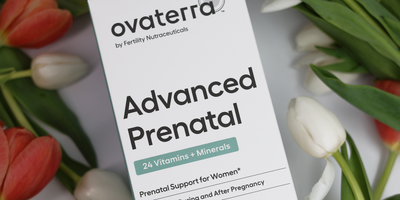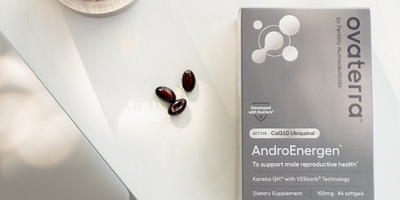Reproductive health often hinges on balance and coordination. More or less of something is not always better, as each contributing part needs to play its role at the right moment. Reactive oxygen species, often thought of as the "bad guy" of metabolism, is no different. Too much leads to oxidative stress, with negative impact on fertility;
What is oxidative stress?
Oxidative stress, in essence, is an imbalance between the amount of reactive oxygen species (ROS) and the body’s ability to detoxify reactive oxygen species. When more ROS accumulates in the body than the body’s antioxidant processes can handle, it’s called oxidative stress.
Oxidative stress can lead to damages in cells and tissues, as well as DNA. Since our reproductive cells – eggs and sperm – are particularly vulnerable to oxidative stress, keeping the balance between ROS and antioxidants can be a key part of reproductive health.
What are reactive oxygen species (ROS)?
ROS is a byproduct of normal oxygen metabolism, primarily taking place within the mitochondria, where a vast majority of the energy we need is produced. Although typically thought of as the “bad guy” of metabolism, ROS actually has key roles to play in the normal physiological processes, including cell signaling, immunity, apoptosis (normal cell death) and activation/deactivation of proteins – among others.
The problem – oxidative stress – occurs when there is too much ROS for the body to handle.
Excessive ROS can damage important components of cellular strctures like lipids, proteins and DNA. This is because ROS has unpaired electrons on the outer shell, which make them unstable and highly reactive. To stabilize themselves, the unpaired electrons in the ROS “steal” electrons from molecules within cells, tissues and DNA, thus damaging them in the process.
How does the body reduce oxidative stress?
Our bodies have built-in mechanisms to neutralize (reduce) reactive oxygen species. For example, mitochondria, where most of the ROS are generated, have the ability to break down some of them. Cells also have defense systems to defend themselves from excess ROS. Some of these defense systems are driven by enzymes; others are driven by non-enzymatic antioxidants.
Antioxidants reduce oxidative stress by targeting ROS production
Antioxidants are molecules that can reduce the amount of ROS by inhibiting oxidation in the body – the process that generates ROS in the first place. Our bodies use many different kinds of antioxidants, including:
- Vitamin C (ascorbic acid)
- Vitamin E (tocopherols)
- Vitamin A, including Beta-Carotene and retinol (preformed Vitamin A)
- CoQ10 (coenzyme Q10), including ubiquinone and ubiquinol
- Glutathione
- Superoxide dismutase (SOD)
- Uric acid
- Lipoic acid (alpha-lipoic acid, or ALA)
Some antioxidants are produced naturally in the body; others come from diet. Interestingly, antioxidants are also used in processed foods to prevent spoilage.
What are the reproductive health impacts of oxidative stress?
Reactive oxygen species have key roles to play in the normal functioning of the reproductive processes, just like in other biological processes in the body. However, oxidative stress from too much ROS have been known to impact reproductive health negatively, in both men and women.
Roles of reactive oxygen species in male reproductive health
Sperm production (called spermatogenesis) generates a significant amount ROS as a byproduct. Here, too, ROS have some important roles to play in normal sperm health. For example, ROS contributes to the process in which sperm gains the ability to penetrate and fertilize an egg (called capacitation). It also helps sperm’s mobility. Immune cells in semen also produce a large amount of ROS to activate inflammatory defenses against infections.
Effects of oxidative stress on male reproductive health
However, too much ROS leads to oxidative stress, which can damage sperm’s structural integrity, as well as its all-important DNA. To protect sperm against excessive ROS, semen contains an array of antioxidants, including glutathione, Vitamin A, Vitamin C, Vitamin E, B Vitamins and CoQ10. Minerals that aid in the ROS detoxification process, like Zinc and Selenium, have also been found in semen.
Even then, sperm’s defense against oxidative stress is relatively limited. This is partly because sperm contains a fair amount of polyunsaturated fatty acids in the plasma membrane, which makes them susceptible to damage from ROS. Another reason sperm is vulnerable to oxidative stress is its limited capacity to repair DNA damage, especially during spermatogenesis.
Scientists agree that a healthy, low level of oxidative stress plays a major role in the genetic integrity of sperm, as well as its ability to move and fertilize an egg.
Roles of reactive oxygen species in female reproductive health
While the roles of reactive oxygen species in healthy male reproduction mostly revolve around sperm health, in women, ROS’ roles go beyond egg development.
Reactive oxygen species are found throughout female reproductive tract, including the follicular fluid (the fluid that fills the ovarian sacks containing eggs), the fallopian tube and endometrium. Importantly, the amount of ROS in distinct parts of the female reproductive tract appears to be precisely controlled at different times, depending on what needs to happen at what point in our menstrual cycles.
For example, ROS is suppressed up to the time of ovulation, then released when the follicle ruptures to let go the mature egg. Because keeping ROS levels artificially low prevents ovulation, scientists believe that ROS is necessary to facilitate ovulation, in a process similar to inflammation.
Similarly, ROS appears to be involved in the orchestration of the luteal phase, when the endometrium responds to progesterone and thickens to prepare for implantation. Studies have suggested that ROS may be one of the compounds that regulate how much progesterone is released from the corpus luteum.
In addition to keeping ovulation and luteal phase healthy, ROS may be involved in egg maturation, where multiple immature eggs are recruited into the maturation journey toward ovulation, with only one eventually reaching ovulation-ready maturity.
The roles of ROS in female reproductive health doesn’t end at conception. There is evidence that a healthy level of ROS is necessary for the maintenance of pregnancy, health during pregnancy and even delivery.
Effects of oxidative stress on female reproductive health
Just like in men’s reproductive health, the key here is the balance between ROS and antioxidant defense system. An excessive accumulation of ROS can tip the balance toward negative reproductive impact, affecting any of the processes ROS plays a role in:
- Egg development and egg quality: Some doctors link oxidative stress to “aging” of eggs.
- Embryo quality: Maternal oxidative stress, as well as exposure to excess ROS have been associated with lower developmental potential in embryos in animal and laboratory studies.
- Ovulation: Imbalance between ROS and antioxidants have been suggested as one mechanism behind irregular ovulation.
- Progesterone levels in luteal phase: Through progesterone, oxidative stress may impact the uterine environment where the embryo needs to implant.
Of course, all of these can impact pregnancy potential overall. Much remains to be illuminated, when it comes to how ROS impacts female fertility, and scientists are exploring potential mechanisms on multiple fronts.
What causes oxidative stress?
Multiple factors can contribute to the imbalance between ROS production and antioxidant activity in the body. Within the body itself, inflammation, immune system activation, infection, too much exercise, stress and aging are known to increase the amount of ROS.
There are external factors, too. When various pollutants enter the body, the body’s defense system to metabolize and remove these pollutants can also generate additional ROS as a byproduct of the detoxification process. Major external sources of oxidative stress include:
- Heavy metals (lead, arsenic, mercury among others)
- Chemical solvents
- Some medications, including cancer drugs, immunosuppressants and certain antibiotics
- Smoking cigarettes
- Alcohol
- Radiation
- UV rays from sunlight
- Smoked meats and repeatedly used oil that has oxidized from heat
Are there tests for oxidative stress?
Many laboratory markers for oxidative stress have been developed, some specific to sperm health or other aspects of male and female fertility. Some of the oxidative stress tests measure the amount of specific ROS or antioxidants like SOD and glutathione. Others measure the activity levels of specific antioxidants; yet others measure the effects of oxidative damage on lipids and DNA.
Ask your doctor about testing for your oxidative stress, if you are concerned about its impact on your reproductive – or overall – health. Quite a few at-home test kits are also available.
What can I do to help reduce oxidative stress on the fertility journey?
We may sound like a broken record, but the usual lifestyle steps to support reproductive health are helpful in managing oxidative stress, too.
- Don’t smoke or drink excessive alcohol
- Reduce exposure to pollutants, like heavy metals and solvents
- Eat a balanced diet, with an eye toward antioxidants like Vitamins A, C and E
- Consider taking a CoQ10 supplement to support egg and sperm health
- Make sure your Zinc and Selenium levels are healthy
- Aim for moderate exercise, but don’t overdo it
- Try to manage stress in healthy ways
- Make sure you get plenty of quality sleep
- Wear sunscreen or wear sun-protective clothing
- Plan to have children as early as it makes sense for you
One note about Zinc and Selemium: These essential minerals are not antioxidants themselves. However, antioxidant enzymes like glutathione reductase and superoxide dismutase need Zinc and Selenium to function. Partly due to their role in our antioxidant defense system, the two minerals have been suggested as key to reproductive health in both women and men.
Take these steps to keep your oxidative stress in check. Even if you don’t test for oxidative stress specifically, these steps will help you support your reproductive health. And please reach out if we can answer any questions about oxidative stress and fertility. We are with you.












